ARA Retail Review 2022
RETAIL SPENDING & DATA
The ARA Retail Review is an annual research report which showcases best-of-breed research for the Australian retail sector and provides an overview of sector performance and outlook. This document is produced in partnership with our community of retail partners and experts.
Message from Paul Zahra, CEO, Australian Retailers Association
Can we be confident or cautious about the year ahead for retail?
After a year of retail restrictions and some of the world’s longest lockdowns, in 2022 we are confronting new levels of complexity around staff shortages and supply chain challenges. As we shift towards a retail recovery, what are the top issues on the minds of our retail leaders? What is driving the retail customer in 2022? And what lessons can we take from the pandemic experience?
The Australian Retailers Association’s inaugural Retail Review features insightful conversations with Australia’s leading researchers and analysts on Australia’s retail sector performance and outlook. We examine the powerful shift that’s occurred in the way people live, work and purchase the goods and services they need, along with a look at the challenges and opportunities that lie ahead for retail in the post-Covid recovery.
As it stands, our recovery from the Delta lockdowns and Omicron is uneven. Some categories of retail are doing better than others with CBD retailers facing prolonged impacts due to the absence international tourists, students and workers. While the border has reopened, it’ll take years for travel patterns to return to pre-pandemic levels and there’s a long way to go to ensure our city centres return to the thriving hubs they once were.
The pandemic has highlighted just how crucial it is for retailers to have an omnichannel strategy so they can cater for customers whichever way they interact with their business. Technology and innovation are playing an increasing role in our sector and consumers are now interacting with brands in different ways and through different platforms. It’s important that businesses continue to harness the power of data and digital as our sector continues to grow and innovate.
Businesses are also turning their attention to the next big global disruptor in climate change. Report after report has demonstrated that Australian consumers want this change and it’s pleasing to see retailers stepping up to the plate already, with 40% of Australia’s retail trade covered by net-zero commitments. With the transition to net-zero, it is no longer ‘if’ but ‘when and how’ we can achieve our goals and business has a critical role to play alongside governments in driving the change we need to see.
Issues like sustainability and diversity, equality and inclusion are becoming key issues for businesses in terms of their customer relationships, as community attitudes have shifted. People are becoming more values-driven when it comes to their shopping and resonate more strongly with the brands that reflect the social issues that are important to them.
The Australian Retailers Association has built an expansive network of partners covering the areas of payments, research, legal and superannuation – all of which have contributed to our inaugural Retail Review. By sharing knowledge and insights we can ensure Australia’s retail sector is better informed to grow into the future.
Paul Zahra
CEO
Australian Retailers Association
Industry
Performance
Retail sector
performance
in 2022
brought to you by


Craig Woolford is the Director of Retail Mosaic and provides research about the retail sector under the MST Marquee brand. The research provides insights to investors and companies about the economic drivers of retail, financial performance of retailers and key strategic issues facing the sector.
There will be unforeseen events, especially in an election year and one where global interest rates are likely to rise.
However, there is a cushion for consumers given their level of savings and decent income growth. Moreover, healthy retailer profitability provides a solid foundation for a good year for agile and shopper-focused businesses in 2022.
We are on a treacherous path forecasting the next 12 months given the turbulence every retailer has experienced over the past two years. Even so, there are some very clear themes that will set the direction for the year ahead, even if precision is a challenge. The most important themes we see are:
- Higher price inflation
- Labour shortages and higher wage costs
- A reallocation in consumer spending
Online may still grow in 2022, but it may be modest, while stores should see a recovery in sales. Online food retail finished 2021 accounting for 7% of all sales and in non-food it was 24% of sales. This compares with 3% and 14% for food and non-food respectively in 2019.
While online will continue to take share from bricks and mortar over the long-term, there has been a distortion given lockdowns. We expect online sales in food to rise 0%-20% in 2022, while in non-food, it could be -5% to +5%.
There will still be strong growth in online sales over the next decade. Based on our research, online sales in food retail will still rise three-fold. For food sold online, solving the problem about the cost of delivery will determine how quickly this rise happens.
In non-food retail, online could double again over the next decade. In non-food, the range offered and the ability for technology to replicate the in-store experience will influence how fast online sales rise across the industry.
Many Australians became online shoppers for the first time and a large portion broadened the repertoire of categories and retailers they were willing to shop online.
Retail category performance could look quite different in 2022 compared with 2020 and 2021.
Household goods sales have risen by 10% per annum over two years, partly a function of the need to make our homes more functional given COVID-19, but also a desire to make our homes a nicer place to be.
Given double-digit historical growth, then a year of decline of 1%-2% in household goods seems plausible. Fashion categories were more impacted by lockdowns over 2020 and 2021 and if the government’s promises are upheld, then a more normal operating environment will result in better sales for fashion retailers.
In food retailing, there will be a normalisation of dining out, which should result in stronger growth for café & restaurants and some weakness in supermarkets. Albeit higher food inflation will help reported sales for supermarkets in 2022.
Household goods sales could decline, while fashion and dining out should see strong sales growth. The strength of each retail category will be influenced by the growth achieved in the recent past.
In summary, higher price inflation, rising wage costs and the reallocation of consumer spending are likely to be the most important issues over the next 12 months.
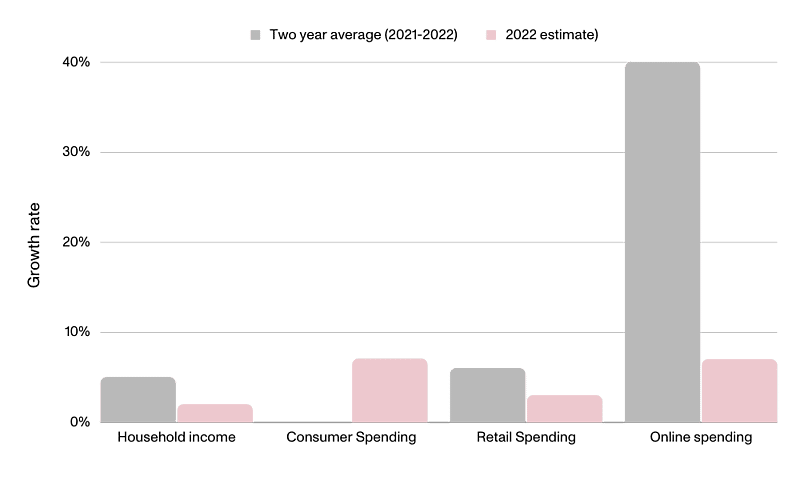
Key issues to watch in 2022
Price Inflation
Wage Cost
Spend Reallocation
Retail sales may rise 3% but household goods may decline and online growth may be single digit.
#1 Price inflation set to accelerate
Consumers are likely to pay higher prices for retail goods creating one of the most topical issues of 2022. Many suppliers and retailers have held off price rises in the hope the spike in shipping and input costs would pass. It hasn’t.
The good news is that some inflation should be positive for retail sales growth in a year where volume growth may be difficult to achieve. Both rental cost inflation and wage cost inflation have typically been linked to economy-wide inflation trends. For the majority of the past twenty years, retailers have had to deal with wage and rent costs rising faster than retail prices. That may look different in 2022.
Expect retail price rises from March 2022 onwards. In some categories, price rises will be 10% or more.
Across the board we expect 3%-4% inflation. While food inflation has been higher than 4% five times over the past twenty years, non-food retail has rarely seen such inflation. The last meaningful rise was the introduction of the GST in June 2000.
While some inflation is welcome, higher retail inflation may feed through to higher interest rates. While official views are that interest rates remain on hold till 2024, the extent of price rises we see across retail could contribute to interest rate increases of 25-75 basis points by the end of calendar 2022.
The other challenge with price inflation is the potential consumer backlash. So far, retail price rises we observed over 2021 have been accepted by the consumer with a minimal loss of volume. Part of this low price sensitivity reflects healthy incomes and high savings by households. As price rises broaden and if interest rates rise, the sensitivity to price rises will increase.
# 2 Labour cost challenge
Retail and hospitality had 36,000 job vacancies as of November 2021. At the same time in 2019, vacancies were 24,800.
Given our perspective on higher retail price inflation flowing through, the risk is that retail wage rate growth is 2.5%-3.5% for the 12 months to 30 June 2023. For most retailers, wages are the largest operating cost. It is likely for some retailers that wage costs rise faster than sales growth, placing a squeeze on company profitability and potentially a reduction in hours rostered.
There was 0% population growth in 2021, when typical growth is more like 1.4%. While immigration will pick up, it may be later in the calendar year.
While higher wages represent a challenge, we do want to balance the discussion by highlighting the positive impact higher wages across many sectors is likely to have across the economy in lifting household income and further improving spending power.
The only logical consequence is higher retail wages over the next 12 months.
The timing of wage increases will synchronise with the General Retail Award wage determination. Relief from higher wage costs will come when there is a normalisation in the supply of labour, which requires a lift in immigration and return of holiday working visa holders.
#3 The reallocation in spending
The reallocation of where consumers spend and how much they spend will have significant impacts on retail categories in 2022. Will the return of travel detract from retail sales? Will online retain its higher share of retail sales?
Before we elaborate on the reallocation debate, our view about the strength of retail spending should put a positive tone on the conversation. In calendar 2021, total retail spending rose 5%. We see growth of 3% in 2022.
The ingredients for solid spending in 2022 will be driven by household income growth of 2% and $400 billion, or $37,000 per household, of savings built up since the start of 2020.
As an aside, to provide context for the size of the savings pool, the average household spends $35,000 a year in retail and $14,000 per year on tourism locally and overseas.
We see the return of international travel as some way off. Domestic travel should recover quickly in 2022 as households look to use up some of their excess annual leave. Greater domestic tourism could help retail sales, particularly in supermarkets, liquor, cafes, restaurants and apparel.
Source: Retail Mosaico.
Global Trends
for 2022
brought to you by


David White / National Retail Leader @ Deloitte Australia
With over 19 years of providing assurance and advisory services to a range of clients, David specialises in the retail industry and leads Deloitte’s National Retail, Wholesale & Distribution Group. This Group comprises retail specialists across all of Deloitte’s service lines, and focuses on providing high quality advice and solutions to Australian retailers, whilst also drawing on Deloitte’s global retail expertise.
As we head into 2022 with a level of caution there is one thing we can be certain of, the pace of change in the retail market is quicker than we’ve ever seen before and retailers need to be agile and brave to stay ahead.
After a shopping frenzy in the lead up to the holiday period, many retailers came back down to reality with a bump as the omicron variant spread like wildfire and burnt consumer confidence. Whilst this was anything but the ideal start, 2022 looks set to be another fascinating year for retailers. Headwinds persist, with rising supply chain costs, limited access to talent and on-going border restrictions resulting in one of the most challenging retail environments we have experienced for many years.
Despite all of this, the future is exciting. New technologies are paving the way for a more immersive online experience, changing consumer behaviour is driving both product and business model innovation, and retailers are finally starting to acknowledge the major role they can play in preserving our planet.
The six key trends:

#1 Retail in a Digital World

#2 Gen Z open their (digital) wallets

#3 Convenience scales up

#4 Circularity & Traceability

#5 Diversification
Expanding beyond the core business and creating value outside of traditional retail channels offers the opportunity for retailers to diversify their offerings and tap into growth markets. This is also being driven by structural changes in retail and conscious consumerism as retailers are forced to diversify to create value.
In the US, Best Buy has sought to monetise its expertise in customer experience by setting up its own in-house media company. Best Buy Ads claims to be able to help other brands with their advertising by leveraging their experience to show more of what interests customers, when it interests them, and how the customer can save money. Walmart has started to leverage its own technology investments to sell its B2B omnichannel capabilities to other retail organisations. We should expect to see many more retailers following suit in 2022.

#6 Distinctive collaboration
Australian Retail Sales
brought to you by


Nicole Piech / Senior Management Consultant @ Mastercard Data & Services
Payments management consulting professional with over 20 years of experience in the industry.
Expertise in strategy & product development, portfolio management, IT and non-IT project management, operations management (including fraud and security), change management and regulatory compliance needs. Extensive experience working both onsite and remotely, managing large teams across the Asia Pacific Middle East Africa Region
COVID-19, now almost in its third year, has continued to impact us all, changing our daily lives and routines, especially with regards to how we shop for retail goods. This article provides a snapshot of how retail sales in Australia during 2021 were impacted as a whole, as well as by Clothing, Department Stores, Household Goods, Food Retailing and Restaurant categories.
Australian Retail Sales ~ Snapshot from the Executive Report Series
January 2021 – December 2021
Total Australian Retail Sales Growth:
Chart 1 below illustrates sales activity over the past two years in comparison to pre-COVID times. The orange line shows total retail sales growth during 2020 versus pre-COVID 2019, while the dotted, grey line shows total retail sales growth during 2021 versus 2019.
As indicated, Year-on-year (YOY) and Year-on-2-year (YO2Y) comparisons of total, national retail sales growth, have shown high volatility due to the significant changes in consumer behaviour that occurred during major COVID-related lockdown periods – specifically April 2020, the mid-point of the first national lockdown, when YOY growth plunged to -7.9%; and July/August 2021 when parts of NSW went into a 4-month lockdown, commencing 26th June.
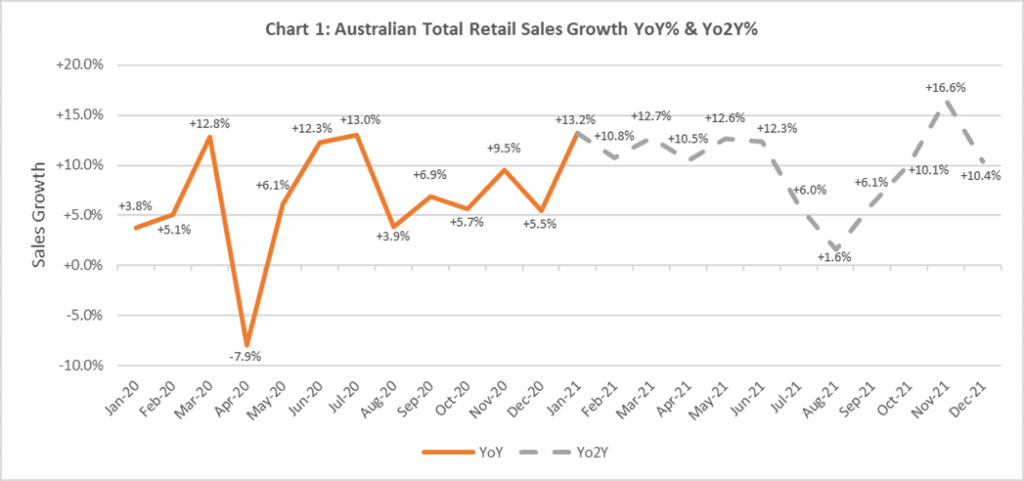
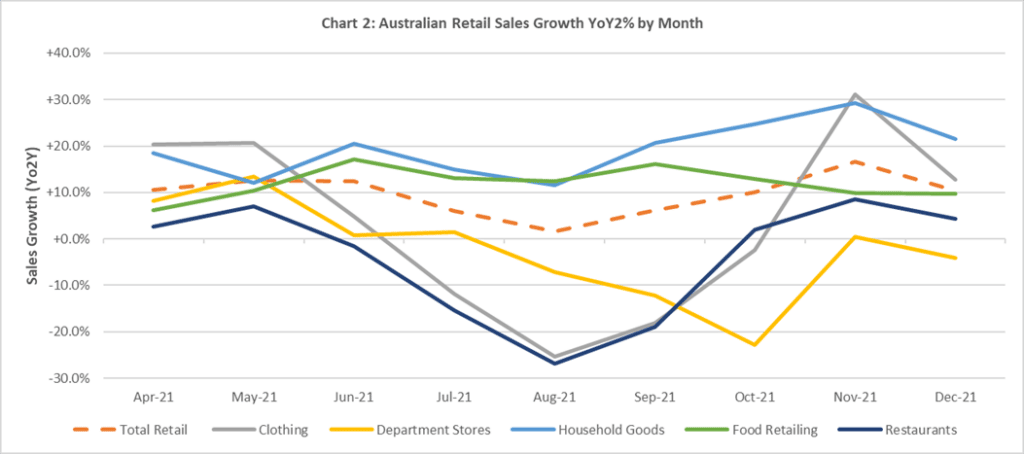
Australian Retail Sales Growth by Category:
At a category-level (Chart 2 – which compares 2021 sales against pre-COVID 2019 sales), we see that Clothing, Restaurants and Department Stores were the hardest hit in the H2-2021 lockdowns, but with Clothing making a very strong comeback on Black Friday in November 2021.
Similarly, we also saw Restaurants trend positively towards recovery following the end of lockdowns and gradual easing of density limits. However, it is anticipated that the sector could slow down in the early months of the new year, with a combination of issues with kitchen and front-of-house labour shortage, delivery driver availability, supply chain uncertainty and ongoing Omicron concerns in the community, all negatively impacting Restaurant spending.
Throughout 2021, Household Goods continued to be the winning sector of the pandemic, with sales further accelerated by people shopping early for Christmas and pent-up consumer demand during the month of November 2021. Further, with disruptions to local and global supply chains, many Australians shopped ahead of the festive season to prevent delivery and stock availability concerns. Another major winner across the second year of the pandemic was Grocery, which continued to benefit from opening as ‘essential retail’ during key lockdown periods and the ongoing consumer demand carried on from the previous year.
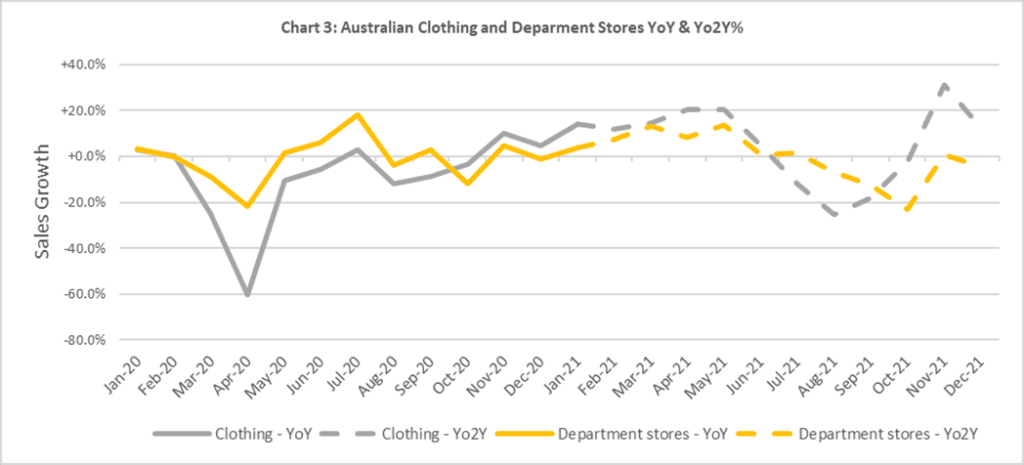
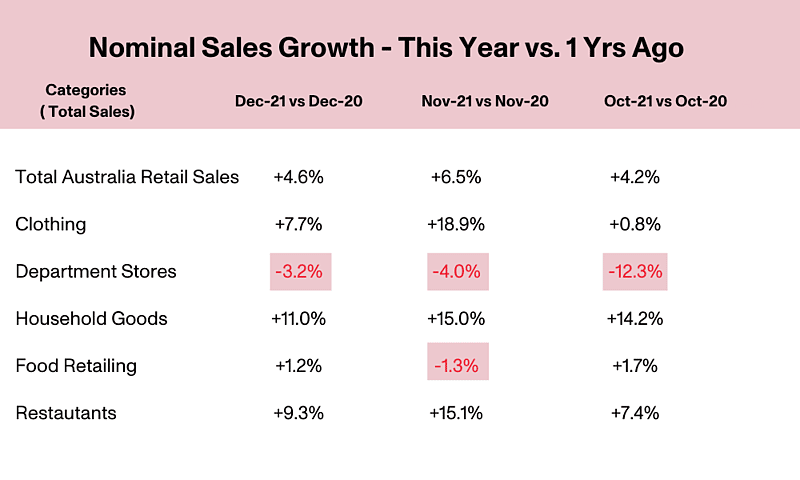
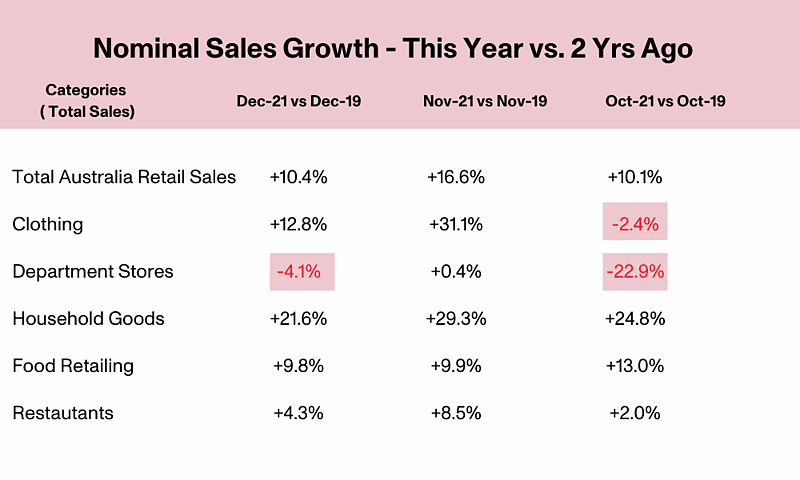
The Mastercard data insights leveraged within this article have been drawn from monthly SpendingPulse™ Executive Reports. Mastercard SpendingPulse™ provides market intelligence findings based on national retail sales across all payment types, including aggregated sales activity in the Mastercard payments network, coupled with survey-based estimates for other payment forms, such as cash and cheques. The monthly SpendingPulse™ Executive Reports spotlight consumer spending by month, year and region for sectors such as Apparel, Grocery, and Online; and include retail analysis of current market conditions. The reports are available in select markets around the world, including Australia, the United States, Brazil, Canada, Hong Kong, Japan, South Africa, and the United Kingdom.
For any general questions or inquiries about SpendingPulse™ please email: Spendingpulse_support@mastercard.com
SPENDINGPULSE™ REPORTS (INCLUDING THIS REPORT) AND CONTENT OR PORTIONS THEREOF MAY NOT BE ACCESSED, DOWNLOADED, COPIED, MODIFIED, DISTRIBUTED, USED OR PUBLISHED IN ANY FORM OR MEDIA, EXCEPT AS AUTHORISED BY MASTERCARD. SPENDING PULSE REPORTS AND CONTENT ARE INTENDED SOLELY AS A RESEARCH TOOL FOR INFORMATIONAL PURPOSES AND NOT AS INVESTMENT ADVICE OR RECOMMENDATIONS FOR ANY PARTICULAR ACTION OR INVESTMENT AND SHOULD NOT BE RELIED UPON, IN WHOLE OR IN PART, AS THE BASIS FOR DECISION-MAKING OR INVESTMENT PURPOSES. SPENDINGPULSE™ REPORTS AND CONTENT ARE NOT GUARANTEED AS TO ACCURACY AND ARE PROVIDED ON AN “AS IS” BASIS TO AUTHORISED USERS, WHO REVIEW AND USE THIS INFORMATION AT THEIR OWN RISK.
Disclaimer: SPENDINGPULSE REPORTS (INCLUDING THIS REPORT) AND CONTENT OR PORTIONS THEREOF MAY NOT BE ACCESSED, DOWNLOADED, COPIED, MODIFIED, DISTRIBUTED, USED OR PUBLISHED IN ANY FORM OR MEDIA, EXCEPT AS AUTHORIZED BY MASTERCARD. SPENDING PULSE REPORTS AND CONTENT ARE INTENDED SOLELY AS A RESEARCH TOOL FOR INFORMATIONAL PURPOSES AND NOT AS INVESTMENT ADVICE OR RECOMMENDATIONS FOR ANY PARTICULAR ACTION OR INVESTMENT AND SHOULD NOT BE RELIED UPON, IN WHOLE OR IN PART, AS THE BASIS FOR DECISION-MAKING OR INVESTMENT PURPOSES. SPENDINGPULSE REPORTS AND CONTENT ARE NOT GUARANTEED AS TO ACCURACY AND ARE PROVIDED ON AN “AS IS” BASIS TO AUTHORIZED USERS, WHO REVIEW AND USE THIS INFORMATION AT THEIR OWN RISK
Online & Ecommerce
The new shopper profiles
brought to you by


Lauren Thompson / Content Manager
@ Australia Post
Shopper habits have changed drastically in the past 12 months, after what was already a huge shift towards online channels in 2020 due to the arrival of COVID-19 in Australia.
In purely quantitative terms, more consumers are shopping online than ever before, evidenced by the biggest November on record for online shopping in Australia last year.* But beyond the standout numbers, consumer behaviour is also changing.
With new habits now firmly adopted, Australia Post research has identified the emergence of four consumer segments within eCommerce in 2021. Each of these Shopper Profiles differs in their preferences, frequency of, and loyalty to online shopping, but all present unique growth opportunities for online merchants in 2022.
The Four Shopper Profiles
Occasional
Shopper
Though the largest in size at 2.8 million households, Occasional Shoppers were responsible for the smallest volume of goods purchased online in Australia last year – 4.2% of total eCommerce transactions – and active online in fewer than five months of the year.
The Occasional Shopper largely returned to physical stores for the majority of their shopping needs in 2021 (or they never left, in states and territories unaffected by mandated lockdowns). When they do shop online, Occasional shoppers are more likely to purchase from Big Brands retailers and less likely to shop with Bricks & Clicks retailers compared to other shopper groups.
Top three Postcodes by percentage of shopper group:
- Woodridge, QLD 4114
- Lakemba, NSW 2195
- West Perth, WA 6005
Active
Shopper
Active online in five to eight months a year, the Active Shopper accounted for 15% of eCommerce volume in 2021.
This shopper may have dabbled in eCommerce occasionally in the past, but their net was cast wider in 2021, shopping from, on average 47% more merchants compared to 2019^.
Top three postcodes by percentage of shopper group:
- Melbourne St Kilda Road, VIC 3004
- Newington, NSW 2127
- West Melbourne, VIC 3003
Very Active
Shopper
Active for nine to 12 months of the year, the Very Active Shopper has adopted online shopping and isn’t looking back, accounting for 31.8% of the volume of goods purchased in 2021.
Data clearly indicates a loyalty within this cohort, with a 78% increase in the number of retailers they visited three or more times in the year compared to 2019, presenting clear retention opportunities for eCommerce retailers.
Top three postcodes:
- Secret Harbour, WA 6173
- Wakerley, QLD 4154
- Ferny Hills, QLD 4055
Super
Shopper
The smallest, yet most lucrative cohort, and active every week of the year, the 1.4 million Australian households described as Super Shoppers account for almost half (49%) of shopping volume in 2021.
Super Shoppers:
- Purchase at least weekly, from 41 retailers annually, on average
- Shop across a span of categories, 60% higher than 2019 (~16 categories in 2021)
- Almost doubled their average monthly purchases in 2021, compared to 2019
- More than doubled the number of merchants they visited in 2021, compared to 2019
- Are more loyal than previous years: merchants visited 3 or more times increased to ~8 in 2021, 1.4 times more than 2019
- Are more likely than other cohorts to purchase from Bricks & Clicks retailers.
2 in 5 (40%) of Super Shoppers are located in NSW, including two of the top three postcodes:
- Frenchs Forest, NSW 2086
- Menai, NSW 2234
- Diamond Creek, VIC 3089
Planning your marketing strategy with shopper profiles in mind
In pursuing growth, merchants must consider which cohort and possibly locality presents their greatest opportunity, and strategies to capture this segment. From improving user experience to creating more engaging customer communications, exploring loyalty programs or geo-targeted advertising, this research presents powerful insight which may be key to a thriving eCommerce channel in 2022.
For more data on the four Shopper Profiles, including locations, top categories and more, read Australia Post’s Inside Australian Online Shopping report 2022, available in March 2022 at https://auspost.com.au/einsights
References:
* Inside Australian Online Shopping report 2022, Australia Post
* Inside Australian Online Shopping eCommerce update, December 2021, Australia Post
* 2019 figures have been used to distinguish a pre-pandemic to now comparison
A new era of retail: future of the store
brought to you by


Jo Gaines / Area Vice President, Retail and Consumer Goods @ Salesforce
Jo Gaines has spent over 20 years working for and with technology and media companies. Since 1999, she has worked for various companies and networks, including Krux, CBS, Yahoo, Kidspot, Sensis and Salesforce As Area Vice President, for Salesforce Digital360.
Jo leads the company’s business development and marketing efforts, focused on commerce and marketing solutions. Prior to joining Krux (which was acquired by Salesforce in November 2016), she served as chief revenue officer at Brandscreen, an independent demand-side platform provider where she managed the Australian commercial and marketing team supporting more than 80 active accounts. Prior to Brandscreen, she was the GM of consumer brands at CBS Interactive and Sales Director at Yahoo!7.
The pandemic heralded a new era for retail with consumers embracing digital channels to engage with their favourite brands from retailer apps and websites to online marketplaces, driving record-breaking online sales.
According to new data from Salesforce, last year’s online holiday sales rose five percent year over year worldwide to $1.14 trillion.
With e-commerce sales at an all-time high and digital shopping habits here to stay, the future of the store may look uncertain. The reality, however, is that the store will continue to serve an important role in how customers interact with brands. According to our research, 59 percent of shoppers want to continue to shop in-store, with the primary reasons to discover and evaluate new products as well as receive in-person customer service. Furthermore, almost a third say they head in-store to enjoy the experience.
While bricks-and-mortar stores will always exist, their capabilities, formats, and technology must evolve to meet new consumer behaviours and expectations for connected experiences across online and in-person.
Large- and small-scale store formats need to evolve to bridge in-person and online
Today’s shoppers engage with brands across multiple online and in-person touchpoints. This means that retailers need to think carefully about their store format in the future, embracing multiple types of formats that complement a customer’s online and mobile experiences from a quick, contactless experience to a long, total brand immersion.
For example, there will be small format stores for the short, grab and go trip, where customers have already purchased items online and are looking for quick and convenient experiences for click and collect. In some cases, these stores will be unmanned where there is no staff on site and no cashiers in store, with discount stores increasingly trialing these formats alongside larger brands like Amazon.
The traditional store format will transform so that customers who have seen a product online can experience it in-store such as in-store beauty tutorials or hair styling sessions. Those traditional store formats may also see retailers innovate by partnering with other retailers for shop-in-shops to drive new customers for each partner. They will also continue to invest in pop up shops, with 26 percent of shoppers visiting pop-up shops in 2021.
A larger flagship store will require more planning to create experiences that meet customer expectations for the best in-store experiences every time they step in-store. These will represent the full brand experience, providing shoppers with the ability to test various types of products including big ticket purchases in real-world scenarios such as household appliances or electronics, for example.
A digital-first store critical to driving stronger connections with customers
It’s not only the store format that will change, but also the technology within the store. To improve the customer experience, retailers need to embrace a range of technologies such as smart digital shelves, digital fact tags, and QR codes – enabling consumers to learn more about a specific product through the use of their mobile device.
As shoppers increasingly use their mobile devices in-store, retailers can leverage artificial intelligence (AI) powered personalisation to drive in-person sales. For example, customers no longer want a generic home page experience, they expect retailers to know what they want and present them with unique and relevant recommendations online, which enables them to quickly and easily find what they’re looking for in-store.
Furthermore, by launching or upgrading existing consumer apps for mobile, retailers can make the shopping experience more convenient and engaging with interactive wayfinding capabilities to identify where products are in-store and their availability, as well as sending real time push notifications alerting the shopper to store-driven promotions for products that are of interest to them. The app also provides a means to drive customers to join a loyalty program, with shoppers willing to download an app and check into a store to earn points. Salesforce reported that, 69 percent of shoppers say that being part of a loyalty program makes them more likely to shop with a brand.
As the role of in-store staff evolves retailers need to upskill in digital
If in-store staff are to meet today’s customer expectations for connected experiences across in-person and online, they will need a unified view of their customer data. According to our research, in-store staff log into an average of 15 systems on a daily basis to do their job. By having a central source for all of their data, retailers can better understand how a consumer is engaging with the brand before they step into a store. It’s never been more important to have quick access to a shopper’s order history with customers no longer willing to accept time-intensive experiences where staff cannot make tailored recommendations to meaningfully up-sell or cross-sell.
Furthermore, as the store adapts to new shopper needs and expectations, so will the responsibilities of in-store staff. During pandemic-induced store closures, staff took on the task of virtual styling, online customer service and online order fulfilment while social media-savvy associates became their retailer’s best brand ambassadors. With these responsibilities likely to remain, retailers need to provide their staff with access to self-learning tools like Trailhead to get them up to speed to manage service and sales across all digital channels.
Every store will become a fulfilment and distribution centre
To deliver on customer expectations for convenient and seamless experiences, retailers were quick to implement new online fulfilment capabilities at the start of the pandemic including click and collect, pick up curbside, and partnerships with third-party delivery providers.
Today’s shoppers have grown accustomed to these store-based fulfilment options with 65 percent of shoppers purchasing a product online and picking it up in the store in 2021. These capabilities will likely become standard features for stores in the year ahead.
By leveraging out-of-the-box capabilities, retailers can better connect the online and in-store experience, unlocking store inventory to be sold and quickly and efficiently turn every store into a fulfilment and distribution centre.
The future of bricks-and-mortar
The store has a long history of evolution to meet new customer expectations, and this is the start of a new journey to blend in-person and digital experiences. While the implementation of store-based fulfilment was prioritised due to the pandemic, more change is coming to the store, including diversity in store formats to meet different shopping needs for convenience, discovery, and service. The interior of the store will see more technology implemented and the in-store shopping experience will be enhanced by the retailer’s mobile app. As the store evolves, the role of the store associate will evolve in tandem. And all of these changes will result in more data that retailers can leverage to enhance their customer experience. To be successful in this new era, retail leaders need to leverage new digital capabilities to create the experiences that today’s customers expect.
State of Leasing
State of leasing in Australian Retail
brought to you by

Olivia Hitchens, Principal @ Hitch Advisory
Olivia regarded as Australia’s leading expert on Retail Law – including in respect of consumer goods, franchising, fitness and beauty and hospitality. Olivia is the exclusive legal advisor to the Australian Retailers Association and regularly comments in the media on matters impacting Australian businesses. Olivia leads a team of expert lawyers in Sydney, Australia (operating domestically and internationally).
Rent has always been one of the major overheads for business. And whilst many industries are downsizing space in favour of remote working in a post-pandemic era, many retailers remain burdened with long legacy lease portfolios that they no longer need, nor can afford.
In addition, retailers and landlords are desperately trying to predict the future of bricks-and-mortar retail – what will customers want? How will they shop? What is the “new normal”? In essence – how do you match your retail footprint to consumer demand when that demand cannot be predicted?
For many years, shopping centres have been the watering hole of the modern world. The place to spend a few hours browsing and grabbing a coffee. The accelerated explosion of online retail combined with the pandemic headache means that foot traffic for most retail destinations is significantly below viable levels. CBDs in particular have borne the worst.
Unfortunately, the pressure of trying to navigate this challenging landscape has pitted retailers against landlords. No longer begrudging allies in the same dance to lure customer dollars towards their shopping oases, retailers and landlords became pandemic adversaries – their interests fundamentally opposed in an environment where customers were non-existent and rents were overwhelming.
The Rental Codes released by Government went some way to help retailers, but landlords bore the brunt of the so-called relief. Whilst some may be unsympathetic that landlords have ‘had it good for so long’, the reality is that the rental relationship is symbiotic. If landlords suffer in the short term, you can bet that this impact flows back to tenants and consumers alike in the long term – in the form of “catch up” rents and in turn, higher prices of goods. Effectively, the Codes were helpful but they were like “Afterpay” for rent. You still need to pay at some point.
So in an uncertain era where foot traffic is down, Omicron is our new best friend and the Rental Codes are ending – what does this mean for the state of retail leasing in Australia?
The current state of retail leasing remains challenging to say the least. Whilst many landlords are offering cheaper rents and favourable contributions to attract new tenancies, existing tenants are left to fend for themselves and to start chipping away at deferred rental balances. Battle weary landlords are reluctant to provide further leeway to tenants and store abandonments and closures are increasing. Even international fast fashion giants are right-sizing rental footprints and closing stores.
What for the future of retail leasing in the years to come then?
We expect vacancies to increase in the short term as some retailers succumb to the challenging environment (and lack of insolvency relief) and others close out-of-lease underperforming stores. We naturally expect some sweetheart rental deals to well performing and in-demand brands to lure them to lower tier centres and vacant offerings. Landlords will have a particular penchant for experience-based and service-based tenancies within shopping centres – think virtual reality, amusement arcades, beauty, hair, pop-up stores for fitness concepts, car brands etc. Short term licenses and “pop ups” for new concepts and promo launches will also be common to fill voids. We are already seeing the top-tier luxury brands swooping on vacant nearby locations to showcase seasonal releases – presumably at a fraction of rental.
Will landlords seek to recoup some of the abated rent they’ve lost via rental increases?
Probably yes for those leases on foot, but only in keeping with fixed annual increases.
Will landlords be aggressive about chasing deferred rent payments from already struggling retailers?
We think so. Many landlords will prefer to have a vacant site and an eviction rather than to allow individual tenancies blanket leniency around rental debts – they know retailers talk and setting ‘rental delinquency’ precedents is a hot topic of landlord boardrooms.
What is the best way for retail tenants to maximise their rental position?
A give and take mentality. In our view, retailers need to proactively offer something to landlords to get something back. For example, a longer time to pay deferred rental arrears in exchange for bringing forward a renewal commitment. Likewise, landlords may offer an existing tenant to relocate to a better vacant tenancy at the same rent, rather than seeing good tenants fail. It is in both parties’ interests for shopping precincts to return to their former glory and we would love to see investment in activations, events, direct to boot concierge and landlord-facilitated amalgamated home delivery from a number of retailers at once. Perhaps landlords could create shopping centre “advisory committees” and get retailers directly involved with strategies to boost customer flow and to brainstorm the best use of marketing and promotional funds?
Reputation
Reputation of Retail
brought to you by


Oliver Freedman / Managing Director @ Reptrak
Oliver is a passionate reputation expert. RepTrak, a market leading global consumer data and insights business, which has tracked the reputation of retail brands for over two decades was established by Freedman in Australia in 2017.
He has used the business to create a conversational bridge between Australian consumers and the businesses that serve them. Prior to that, he was Managing Director of AMR, one of Australia’s leading Market Research companies and also worked for Harris Interactive in the US.
Perceptions of the retail industry continue to be incredibly stable with close to three quarters (71%) of the Australian public stating it has a good reputation and just 7% stating it has a poor reputation. This level has not significantly changed over the past two years, with the pandemic, surprisingly, having little impact on how the public regard the industry.
The sudden and previously unthought of lockdown measures instituted at the end of March 2020 resulted in many Australians having to reach out to companies to ask for assistance as well as the Federal Government implementing Job Seeker and Job Keeper and asking companies to assist ‘Team Australia’. Generally, these events and the response from Corporate Australia through extremely generous ‘hardship provisions’ led to an overall increase in trust, admiration and respect for many industries and companies. As lockdowns have been lifted and then reinstated over the past two years, we have witnessed a pattern whereby reputation for companies improved during periods of lockdown (referred to as ‘covid bumps’), with the improvement softening once lockdowns were lifted and life was perceived to return to ‘normal’.
This pattern between tightening and loosening of restrictions and general attitude towards Corporate Australia has been maintained. Therefore, a Covid ‘bump’ was recorded during June-August 2021 lockdowns and dissipated once restrictions were eased in September-December.
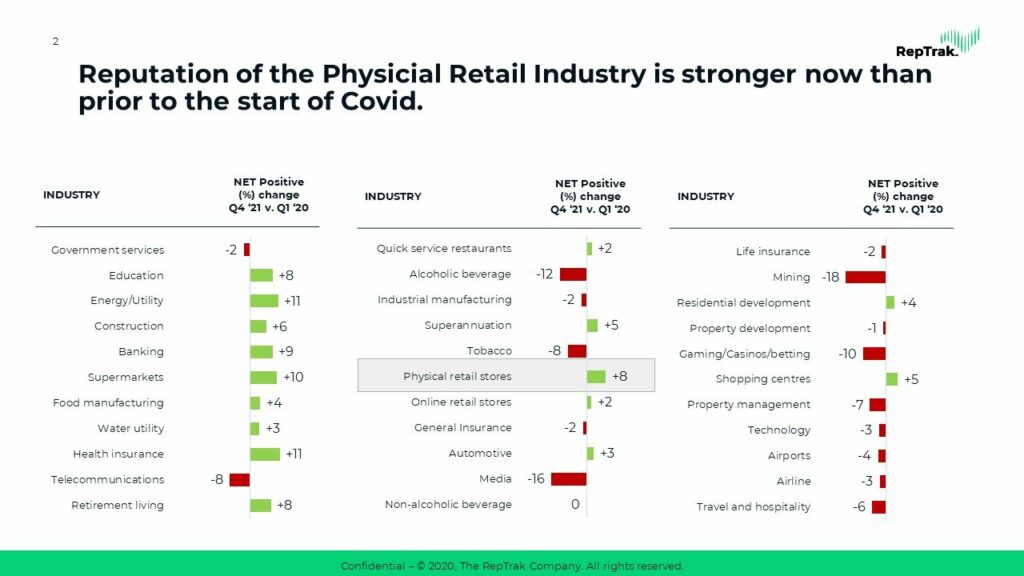
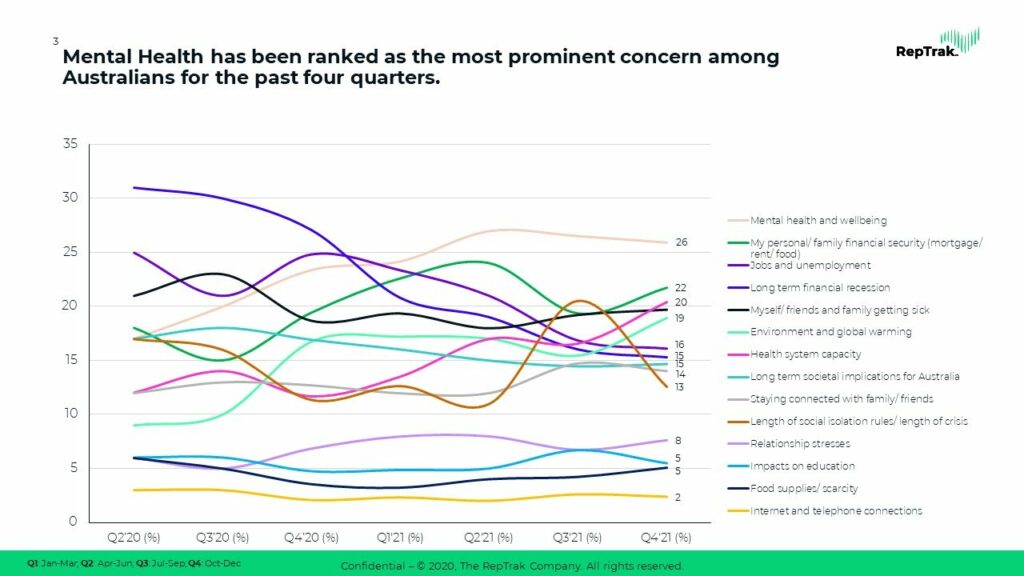
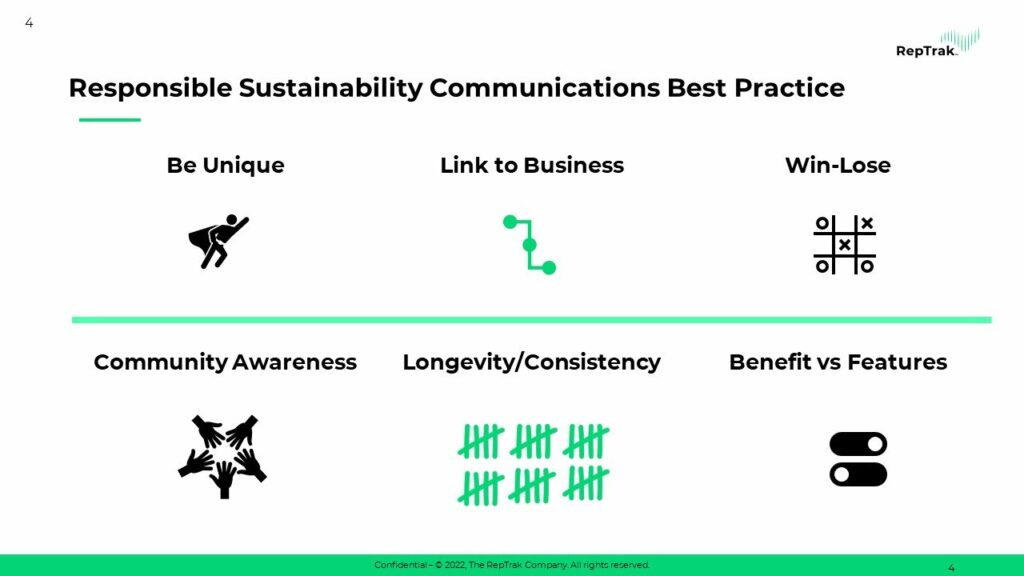
Finally, at RepTrak we are often asked what makes a successful community program; how can companies avoid accusations of tokenism or ‘greenwashing’. We have developed a list of six considerations that we believe will assist in increasing the positive reputational impact of community actions or programs.
- Be Unique – the program needs to be associated with your company. While, for example, donating to natural disaster campaigns are expected by the community, they are less likely to have a significant reputational impact due to the large number of companies undertaking such activites.
- Link to Business – the ability to show how the program links to a company’s core operations, values, purpose or overall strategy should also help increase its reputational impact. The ability to utilitise a company’s known assets in the delivery of the program is often a factor in the reputational benefit it provides.
- Win-Lose – In business literature, much has been written about finding Win-Win situations. It is our belief that when it comes to companies engaging with the broader community, the community sees a Win-Win (i.e. where the community gains and the company gains financially) as good business but not good corporate behaviour. Rather, the community is looking for situations where the company sacrifices something to help the community.
- Community Awareness – If the community is unaware of the activities or programs, they cannot change or improve their attitude. Communications around this area must be done with authenticity and humility but it is our belief that informing the community is essential.
- Longevity/Consistency – this is one of the most difficult components as it requires time and patience. The ability of a company to maintain its programs over a longer term provides evidence to the community of its commitment and builds authenticity.
- Be Clear on the Benefits – companies need to communicate the positive impact the programs are having on the environment or on the community rather than merely explaining the activities. While the features and specifics are essential for its success and are often the subject of internal discussion, the benefits are more likely to drive positive reputational impact.
Consumer Trends
Emerging Trends
brought to you by


Gary Mortimer, / Professor of Marketing and Consumer Behaviour @ Queensland University of Technology
Prior to joining QUT, Professor Mortimer spent over 25 years working with some of Australia’s largest general merchandise and food retailers. In 2020, he was appointed as the Chair of the Australian Retailers Association (ARA) Consumer Research Advisory Committee and to the Expert Advisory Group for the NSW Department of Planning, Industry and Environment Employment Zones Reform.
Professor Mortimer also sits on the editorial boards or the Journal of Retailing and Consumer Services and International Journal of Bank Marketing. Widely recognised as Australia’s leading retail expert, industry keynote speaker and media commentator. He works closely with Australian television, print, online and radio media to engage broadly with audiences, outside of academia.
Customers are continuing to demand alternative ways to transact, from digital payments, Scan&Go, and now the emergence of Facial Recognition Payment options.
In 2021, the Australian Retailers Association (ARA) committed to developing a range of knowledge-based resources for members, which would facilitate evidence-based decision making. Strategically linking with Queensland University of Technology (QUT), the partnership is leading to deeper insights in consumer behaviour and how it affects Australia’s $360 billion retail industry. Together, with some of our leading ARA members, we are helping fund and create the generation and publication of new research. A year in, we speak to the ARA Chair of Consumer Research, Professor Gary Mortimer about the key themes that have emerged throughout 2021.
Three clear themes have emerged, informed by committee members, and addressed by key researchers, namely, emerging retail technology, the future of retail work and the challenge of sustainability.
The Rise Of Technology
Customers are continuing to demand alternative ways to transact, from digital payments, Scan&Go, and now the emergence of Facial Recognition Payment options. Scan&Go options, where customers simply scan their own purchases with their smartphone, and then checkout, are now becoming more prevalent. Woolworths is continuing to role the option out across stores, and 7/Eleven is beginning to trial this ‘checkout queue busting’ frictionless in-store experience. The ARA sought to identify emerging retail transaction-based technology.
Facial recognition payment (FRP) technology is a controversial innovation. On the one hand, it represents an advance in biometric methods which will enhance service efficiencies and consumer experience; on the other hand, consumers’ privacy concerns and trust issues make it harder for the technology to be adopted. In 2018, there were 61 million FRP users in China in 2018 and it is estimated that this number will exceed 760 million this year. A key issue facing retailers today is understanding their customers’ knowledge about FRP, and their motivation to trial and adopt this technology.
The ARA found while 34% consumers had heard about Facial Recognition Payment (FRP), only 10% had used it. Overall intention to adopt and use FRP is low for grocery shopping, slightly higher for non-grocery retailers. Interestingly, consumers prefer to undertake their first FRP experience with a trusted physical retailer. Younger customers (<45 years) tended to perceive higher levels of FRP convenience. Security, privacy and data storage concerns were consistently high between age groups and retailer categories. This indicates the importance to reduce security concerns as a main marketing communication strategy.
A second technology driven trend was ‘location sharing’ – that is the customer’s willingness to allow the retailer to track their movement around a store. Simply, a smartphone accesses customers’ geographic locations in the store, tracks their movements, and allows retailers to offer meaningful, personalised services which are more valuable, accurate, and provide useful information for both customers and retailers. Over the past decade, major retailers like Macy’s have adopted ‘beacon’ technology, which enables shoppers to ‘opt-in’ and receive personalised offers as shoppers wander the store. Brands like Estimote and iBeacon are beginning to emerge to facilitate this connection between the retailer and their customer. Naturally, privacy and trust issues may become a barrier to adoption.
ARA research identified over 55% of shoppers surveyed were willing to share their location with a retailer. To increase adoption rates, the ARA found that communicating the benefit of data sharing encouraged 70% of shoppers to turn on their location for retailers. From a range of ‘benefits’, financial benefits (discounts, personalised offers, points) increased shoppers’ intentions to share their location. Privacy concerns naturally reduced those intentions.
THE FUTURE OF RETAIL JOBS
THE ENVIRONMENT & SUSTAINABILITY
Predicting consumer trends is about exploring the unpredictable
brought to you by


Andrew Gorecki / Managing Director @ Retail Directions
Consumer attitudes and behaviours have changed substantially during the pandemic. The added challenge is determining which of the changes are permanent and therefore require business realignment, and which are temporary that retailers simply need to ride out.
Predicting the future has never been easy, but when it comes to consumer trends and behaviour, the last two years have shown us that predicting the unpredictable is more difficult than ever. As a result, it’s now become less about tracking consumer trends and more about looking at consumer priorities.
And there’s also a degree of chaos in the current regulatory-socio-economic landscape – from supply chain blockages to labour shortages – as well as soaring inflation and energy prices that continue to increase consumer uncertainty and cause them to tighten purse strings.
Such constraints aren’t going away anytime soon, so retailers need to position themselves and their businesses to become more flexible and responsive to both the expected and the unexpected.
Planning across multiple likely scenarios would enable retailers to consider a range of possible futures, as the most likely future can’t be predicted. Scenario planning and looking at leading indicators in other markets – such as the UK, which is looking to be one of the first countries to emerge from the pandemic – can be helpful exercises to ensure business survival.
How have consumers changed?
Consumers have evolved in many ways during the pandemic, from how they spend to how they behave. The most significant changes have been driven by the choice or necessity to spend more time at home and avoid crowded places, forcing customers online instead. This impact is likely to remain unchanged until government restrictions ease and the threat and fear of Covid wanes. Only then will we see if this behavioural change is permanent.
Different shopping patterns and consumer behaviours have emerged as consumers have changed what and how they buy, as well as how much they might spend. Figures from the Australian Bureau of Statistics1 show falls in spending on categories ranging from transport to accommodation, recreation, and entertainment.
For some, the additional disposable income saved from not commuting or spending less on eating out or travelling may have caused a false sense of security, but warnings around rising inflation, soaring energy bills, and subsequent price rises seem to be hitting home.
National Australia Bank’s latest Consumer Sentiment Survey2 suggests that 37% of consumers are now mindful of where they spend their money, with a strong bias toward supporting local businesses. The consumer is becoming more value-led.
The fluidity of consumer priorities is highlighted by hard-hit sectors, such as foreign holidays and formalwear, where spending plummeted during the pandemic. Only when confidence and the ability to travel and socialise return, will these sectors be likely to regain at least some level of prosperity – showing just how hard it is to plan around supposed new ‘trends’.
The consumer is eager to take back control too, a point highlighted in the most recent EY Future Consumer Index3, which says customers are eager to stop reacting to events. It also highlighted a trend of spending less but buying better. During the pandemic, purchases were largely driven by availability rather than brand loyalty and, as we emerge from the pandemic, those retailers that are honest with consumers about what is available, as opposed to promising the undeliverable, will earn greater trust.
What consumers now want from retail – confidence and convenience
Despite the vast change in consumer behaviours, and the fluidity of those changes, it’s safe to say that consumers have two very definite priorities in their buying journey now. They want confidence and they want convenience.
How retailers need to be reacting to these consumer trends
These shifting consumer priorities demand change – whether they are here to stay or not. For retailers looking to boost consumer confidence comes the need to concentrate on the basics, ensuring a safe in-store experience that includes easy to use POS for swift transactions and social distancing, so that consumers looking to shop in-store can do so safely.
Gen Z has arrived - and spending and saving will never be the same again
brought to you by


Ciara McGoohan / Vice-President of Customer Science & Strategy @ Afterpay
Ciara is responsible for generating additional value for Afterpay’s merchants from the wealth of data that is harnessed from millions of customers. Ciara is the former General Manager of Insights & Advanced Analytics at David Jones and Country Road Group, where she was responsible for driving customer centric and data-driven decision making across the organisation. She previously worked for Mastercard Data & Services, where she built the Retail & Partnerships business across ANZ.
This year the oldest Gen Zers turn 25 – they are breaking out into the world and making their presence felt.
Having spent some of their formative years in truly unique circumstances, it is already clear that their expectations and behaviour will be unlike that of their predecessor.
To help better understand the shopping habits of younger generations, Afterpay has established the Next Gen Index – working in partnership with the Australian Retailers Association. The Index is a quarterly economic series on consumer spending behaviour and trends, with a focus on Gen Z. The insights provided recognise the growing power of younger generations in the economy, and how their behaviours and preferences are shaping the future of commerce. The series also shines a light on the role of Buy Now Pay Later in the changing landscape of consumer spending and payments.
Most recently the Index has shown us that as Covid restrictions ease, younger generations are leading the charge to get back out into the world. Sales growth for recreation products skyrocketed on Afterpay after the end of lockdowns in NSW and Victoria, exceeding 300% year on year. Travel and events spend has also climbed above 150%. For younger Aussies outdoor equipment, party supplies, hobby accessories and pet products all saw a big surge – speaking to the desire to get outside, exercise and socialise.

Our two-speed recovery
brought to you by


Michele Levine / Chief Executive Officer
@ Roy Morgan
With over 30 years’ experience as a researcher, Michele has been responsible for thousands of surveys, including many of the largest research projects ever undertaken in Australia, many of which continue to play a critically important part in shaping our society today.
The retail sector is experiencing a two-speed recovery, but who is driving the fast lane and who’s stuck in the slow lane?
As the retail economy recovers, the architects of recovery are not economists or politicians, they are consumers.
But not all consumers are equal. Roy Morgan data reveals that consumers contribute asymmetrically to the retail economy. What we have is a two-speed economy and a two-speed recovery fuelled by consumers of unequal value.
The fast lane of the recovery is being driven by 4.8 million big-spending Australians for whom spending is driven by desire, and price is just the cost of falling in love. Simultaneously ten million price-based traditional Australian consumers are stuck in the slow lane.
Distinguishing the difference between the two is critical for retailers.
The big-spending fast lane consumers are known as the new economic order or NEOs. We also call them Premium Consumers because they spend more, more frequently and are prepared to pay a premium if a retailer gets them to fall in love with its brand and the products it sells. Click here to know more about Premium Consumers.
Ninety percent of these NEOs are in the Roy Morgan Big Spender category – that’s the top third of discretionary spenders in the economy.
The traditional consumers in the slow lane of the two-speed recovery are reluctant spenders. Regardless of their income or net worth, Traditionals are price-sensitive and more interested in the right deal than they are in the right quality or a premium experience. As a consequence, only 6 percent of Traditionals are in the top third of discretionary spenders.
So, the Australian economy has bifurcated into two distinct consumer mindsets – one delivering high growth and high margins, the other delivering significantly lower growth and low ‘commodity margins’.
How does this play out in the retail economy?
At Roy Morgan, we forecast retail sales for the ARA and its members. Forecasting retail sales for the 2022 calendar year and comparing them with 2021 sales, the modelling reveals that the fast-lane NEOs not only spend more (26 percent more) but are also the growth engine of the retail economy.
In 2022 NEOs are forecast to deliver 11 percent retail sales growth – 3.7 times higher than the general population, and 11 times higher than Traditional customers.
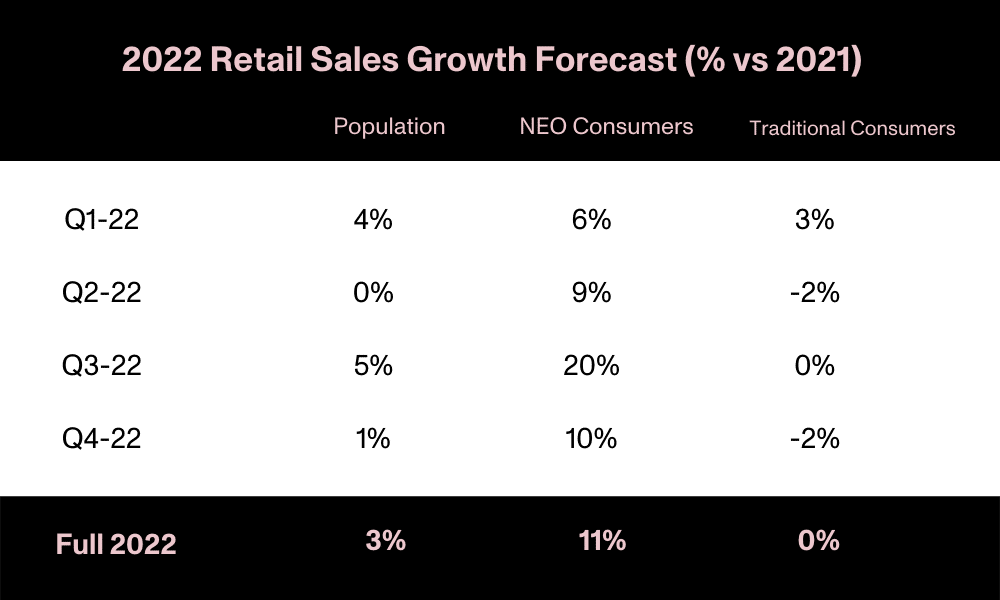
Retail sales and retail sales growth need customers to be certain and confident, so what role does consumer confidence play in the two-speed recovery?
Consumer Confidence during GFC
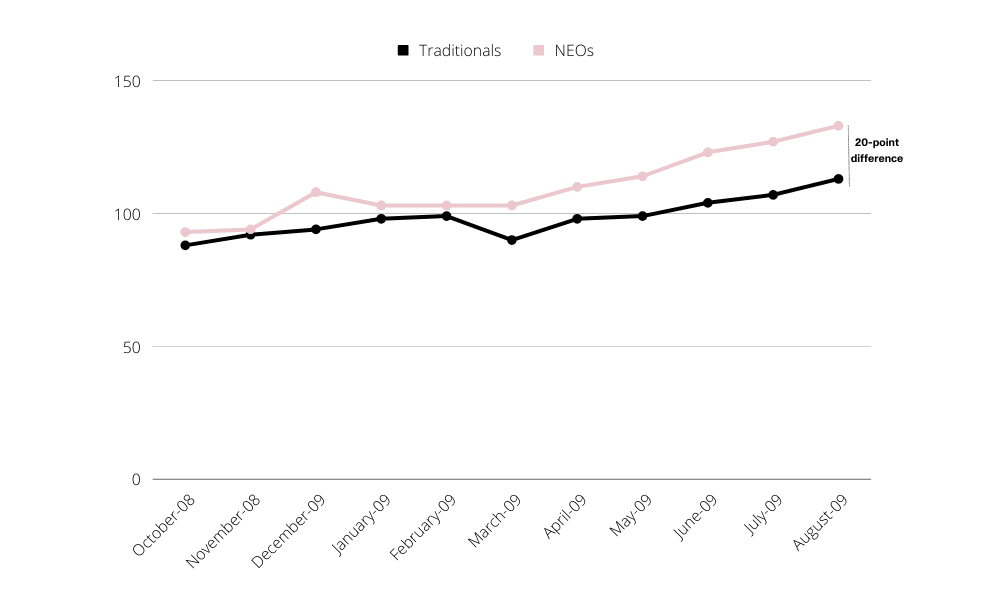
NEO shoppers are more confident than the population in general and Traditional shoppers in particular.
After economic slumps, NEOs recover first and fastest. During both the Global Financial Crisis and the COVID Recession, NEOs quickly regained their confidence to be 20 points ahead of Traditionals: bifurcation of the consumer economy in action.
Now, back to the retail economy. In 2018 professional services firm Deloitte announced that it also had identified a bifurcation in the retail sector.
Deloitte found that retail spending behaviour in the US had split, with sales growing at faster rates for Premium retailers than for Price-Based retailers – with little or no growth in-between the two streams. They called it the Great Retail Bifurcation.
They found that over 5 years Premium retailers saw their revenues grow by a remarkable 81 percent while Price-Based retailers saw their revenues grow by a creditable 37 percent. Retailers caught in-between Premium and Price-Based, however, grew by only 2 percent
NEOs and Traditionals are so different they may as well be on two different planets, so NEO creator and social scientist Dr Ross Honeywill and I have for more than a decade been using a two-planet metaphor to describe the consumer economy bifurcation. A retailer on Planet NEO can generate high sales growth, higher margins, and strong revenues – but its values had better align with NEO values.
Over on Planet Traditional, a business can have low margin / high volume success – but it better not have the second-best price.
Consumer Confidence during COVID
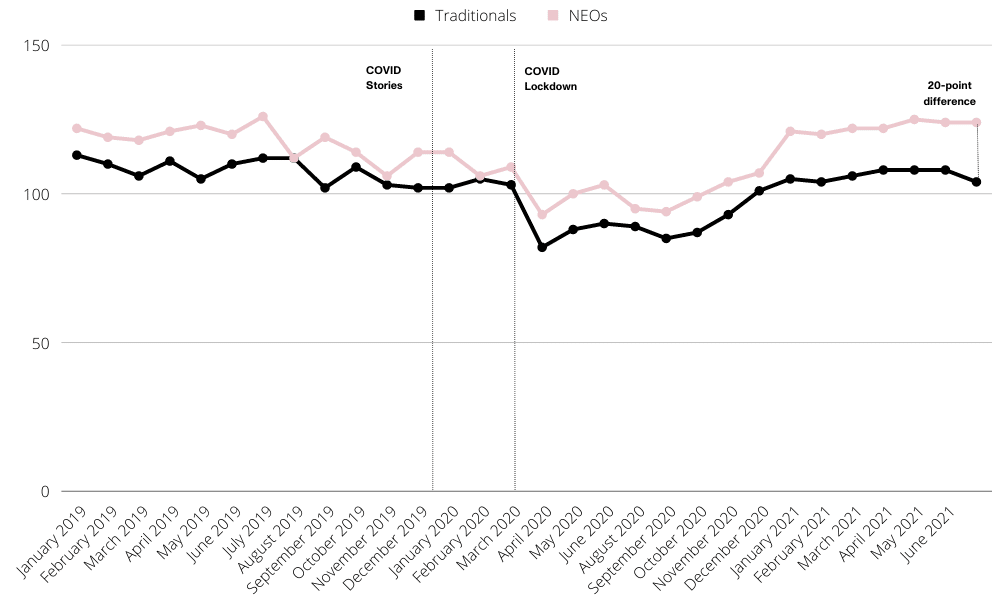
So far I have used the word ‘price’ quite a lot. After all, retailers have for decades worked hard to identify the price customers are prepared to pay.
In the two-speed recovery, however, we need to stay ahead of the curve, and identifying the price customers are prepared to pay is not staying ahead of the curve. Staying ahead of the curve means identifying the customers prepared to pay the price.
Future shaping NEOs are prepared to pay, but only, as I said earlier if a brand aligns with NEO values.
Take Apple for example. It has clear brand values: socially progressive, design-driven, edgy, individualistic, self-aware. It knows what it is and importantly knows what it is not.
Apple never discounts so its customers have to be prepared to pay. Apple exists for the individual – its mantra is, every thing we touch enhances each life it touches.
It’s easy to see who Apple’s customer is, someone who has progressive social values, who values design and beauty ahead of function and features, who takes the path less travelled, who is individualistic, who looks for products that enhance their lives, and for whom price is just the cost of falling in love.
Less than a third of Traditionals (32 percent) own an iPhone but the majority of NEOs (54 percent) own iPhones. Put another way, shoppers on Planet NEO are 53 percent more likely than shoppers on Planet Traditional to buy an iPhone.
After Apple’s own stores JB Hi-Fi is Australia’s top iPhone retailer, withNEOs much more likely than Traditionals to buy their iPhone from JB Hi-Fi.
Former JB Hi-Fi marketing director, Scott Browning, reflecting on a decade of NEO growth for the retail brand said:
“In the mid-2000s we were searching for who the JB Hi-Fi customer was. We were desperate to find something that we could build data and strategy around, and we came across NEOs. Using Roy Morgan data, we ran the NEO profile across our business and found about 45 percent of our customers were NEOs. And then we did the formulation of value and found NEOs accounted for upwards of 80 percent of value to the business. Since then NEOs have really transformed the business. If you follow the NEO you find the future.”[1]
[1] From Mi3 podcast, Finding NEOs: How 4.7 million Australians will drive a two-speed recovery, 2 March 2021
So, as the two-speed recovery gains momentum – or rather as its fast lane gathers momentum – retailers require a new lens and new metrics. The future is being shaped by a new economic order, and retailers need to recognise the new normal. It’s going to determine the winners and losers.
Small Business
Backing small business agility and growth
brought to you by


Jee Moon / Vice President Merchant Marketing and Business Insights, Asia Pacific @ American Express
Jee Moon, Vice President, Merchant Marketing and Business Insights, APAC, American Express has over 20 years of management experience, leveraging data to transform businesses across retail, banking and telecommunication sectors.
The resilience and passion small business owners have shown over the past couple of years has resounded across the nation.
No one needs to tell operators how challenging the fluctuating conditions continue to be – they’re living and breathing it every day.
The Australian Retailers Association estimated the daily impact on retail trade during the last 2021 lockdown was over $44 million a day in NSW and over $55 million a day in Victoria1. While many of us thought the start of 2022 would bring a sense of optimism to the sector, global supply chain issues, staff shortages and the impacts of Omicron continue to force retailers to demonstrate grit, tenacity and an ability to adapt to the toughest of conditions.
It is our hope that a level of normalcy soon returns for us all and with that, a strong recovery to the sector. Small businesses are the backbone of our economy. Across Australia, 80%2 of American Express’ merchants are small businesses but they’re much more than a percentage – they’re the heart and soul of the communities where we live and work.
Embracing the acceleration of technology and digital payments
According to the Global Business Spend Indicator survey research, for small businesses surveyed who expect to spend more on technology, 26% say their customers expect a higher level of digitalisation and automation in the products and services offered while 32% see investment in technology as being crucial to remain operational in the context of the pandemic3. More than half of small business respondents (56%) will spend more on automation3.
Increasing supply chain resilience
42% of Australian small business survey respondents say they won’t spend anything with suppliers based outside of the country3. For operators who have overseas relationships, consider the geographical location of your suppliers and if there are alternative, local options who are less impacted by global supply constraints that the market is experiencing.
21% of small businesses surveyed say they expect to increase the use of an existing credit or charge card to make supplier payments3. Small businesses may be able to realise reward benefits from business credit or charge card usage while also increasing operational flexibility via extended payment windows. The result may enable small businesses to optimise their working capital, so they have more cash flow available to meet daily operational expenses.
Supply chain issues are forecast to create strife and delays across the retail sector for some time. In response to market pressures, small businesses can review their supplier relationships to streamline operations, seek greater flexibility, and realise cash flow benefits.
When it comes to enhancing key relationships with suppliers, 37% of small businesses surveyed say discounts on early payments would be most helpful to their business3, while 27% see value in receiving a discount when making bulk purchases3. Relationship building is even more crucial right now so approach your supplier relationships as mutually beneficial for both parties.
Small businesses can review their current supplier payment terms to realise advantages, such as extending re-payment terms by an additional 15, 30 or 60 days.
Improving supplier relations and increasing flexible payment processes will enable small businesses to streamline their operations this year, bolster their business resilience and enable them to spend more time recalibrating for growth.
Making the most of spend behaviours: shopping small and shopping local
85% of Australian consumers surveyed say they are most likely to head in store as small businesses start to reopen, with 46% of those people citing they miss the physical in store experience and 57% of them making a conscious effort to hit-up their local high street as they want to help their local small businesses survive5.
Looking ahead
Fluctuating marketing conditions mean small businesses need to have the capacity and systems in place to operate with ongoing agility and resilience this year. Living in a post-pandemic era will likely see many small business operators embrace hybrid models, redefining the best of in-person experiences in tandem with digital operations. While COVID-19 has spurred investment in technology and innovation, these components will remain fundamental aspects of small business planning to bounce back and come out stronger than ever before.
[1] ARA-Roy Morgan Pre-Christmas Sales Retail Predictions, 21 Oct 2021
[2] American Express internal proprietary data 2021
[3] American Express Global Business Spend Indicator Survey Research – Edition 2, August 2021
[4] American Express Australia internal proprietary data June – August 2021
[5] America Express Shop Small Survey Research by Lonergan, October 2021.
Risk
Risk Mitigation
brought to you by

Olivia Hitchens, Principal @ Hitch Advisory
Olivia regarded as Australia’s leading expert on Retail Law – including in respect of consumer goods, franchising, fitness and beauty and hospitality. Olivia is the exclusive legal advisor to the Australian Retailers Association and regularly comments in the media on matters impacting Australian businesses. Olivia leads a team of expert lawyers in Sydney, Australia (operating domestically and internationally).
My analogy of the retail industry in 2020 and 2021 is similar to my experience of learning to surf.
Just when you are on top of the wave and finding your feet, Covid surges forward and sweeps the board out from under you.
Just like surfing, there are moments of calm and then, without prediction, moments of choppy seas and uncertainty. Retailers have constantly been looking over their shoulders, trying to predict the next wave, and simultaneously looking to the metaphorical shoreline for a rescue boat from the Government, landlords and suppliers.
Now that Government support and Leasing Code protections are ending, what can retailers do in 2022 and 2023 to get ahead of the wave and prevent wipe-out (no more surfing pun I promise).
Whilst the retail landscape remains uncertain, retailers can take steps to protect themselves and future proof as best as possible.
Here are our 5 tips
Tip 1: Business Structure
See an advisor (e.g. lawyer) to review the way in which you operate your business. Do you have more than one store? Do you hold all your leases all in the one entity? Is that the same entity that holds other valuable assets?
Do you have stores that aren’t performing? Can you terminate those leases?
Have you given personal guarantees? If so, what is your personal asset ownership structure and is your home exposed if the business takes a downturn?
These questions (and more) need to be answered with the help of a professional advisor to make sure you minimise your personal exposure and that you quarantine trading risk away from business assets – as best as possible
Tip 2: Lease Reviews
Review your rental debts (particularly deferred rent balances) and speak with your landlord about ways in which you can have some reprieve – whilst doing something for the landlord in return. If you are struggling to meet rental payments and deferred rental balances are looming, offer your landlord an incentive to provide you some further time to pay or waiver (e.g. early renewal etc).
Consider whether you can “give back” some leased space, sublease or surrender up a non-performing store early. Is there a cheaper vacant premises within a centre that you could move to?
Now is the time to get on the front foot with landlords, don’t wait to be evicted.
Tip 3: Supplier Negotiations
As with your landlord, it is important you are proactive with your suppliers to try and get more favourable payment terms and better pricing/rebates.
Likewise, have frank discussions with logistics providers and suppliers about supply chain challenges and delays to see what can be done to get stock into stores quicker. Consider whether there are alternative suppliers and whether you can source product elsewhere.
If you have surplus stock or unworkable purchasing commitments, consider whether you can request a buy-back from your suppliers or resell unwanted stock via other channels.
If your delivery partners are letting you down, explore the raft of second-tier and last mile delivery options that are available in the market
Tip 4: Workforce Review
Undertake a review of your employees and workforce to ensure you are getting the most out of your labour force. That is, whether employee roles need to change to meet the current climate, whether you can consolidate positions or pivot workers into different roles/locations. This requires knowledge of the applicable Awards but also an understanding of your employment agreements. If they are outdated, get advice on the best way forward.
Are you taking steps to protect your workforce from Covid disruption? Continue to implement A and B teams to reduce close contact transmission and disruption due to isolation timeframes. Make sure you have clear Covid and sick leave policies and are doing your best to minimise workplace transmission.
Tip 5: Financial Planning
Work with a great accountant and planner to prepare a budget and forecast. Monitor your cashflow constantly. Refinance and consolidate debt if necessary. The main goal being to ensure you plan for the worst and aren’t left exposed. Financial planning and budgeting should go hand in hand with your legal structuring in Tip 1 – to ensure you are mitigating risk as best as possible. Don’t wait.
Reach out if you need any help implementing the above. The team at Hitch Advisory are experts in advising retailers of all shapes on sizes on the best strategies to improve their business position – and you have a 30 minute free consultation as part of your ARA membership. Swim don’t sink
Workforce threats facing employers
brought to you by


Kirsten Mills / Head of Affinity Australia @ Marsh
People-related risks have exposed threats to the health and wellbeing of the workforce that affect the overall resilience and success of a business.
It has never been more important to tackle people-related risk.
Marsh uncovers new research shows the greatest likelihood and impact of 25 workforce-related threats facing employers in Australia and worldwide.
COVID-19 has put people-related risks firmly on the agenda, reinforcing that employee risk protection insurance and wellbeing plans are central pillars of the employee value proposition.
“People are an organisation’s most important strength, but they can bring significant risk to a business if not properly managed.” Sarah Brown – Mercer Marsh Benefits Leader, Pacific.
The 2021 Global Risks Report, published by the World Economic Forum in collaboration with Marsh McLennan, highlights the major threats that are likely to reshape our world over the next decade. Unsurprisingly, people risks – along with digital, remote working, political and societal risks – dominated the landscape, bringing new challenges that are both constantly evolving and critical to address. The Five Pillars of People Risk report provides insight into these identified challenges.
The top emerging risks identified in Australia:
#1
Maintaining workplace culture, compliance and supervision has become more difficult as firms have needed to balance the increased dependence on remote working, particularly from home.
#2
Employees have suffered from escalating deterioration of mental health due to the spread of COVID-19.
#3
Closed borders in Australia have exacerbated the war on talent and the ability of organisations to attract and retain people.
#4
Governance requirements around safety and employers’ obligations to provide a safe working environment was heightened during the pandemic.
#5
Rising insurance costs across the board mean organisations cannot afford to be passive when it comes to claims management for work or non-work related injuries.
#6
Concerns regarding cybersecurity and data breaches have been heightened by COVID-19 and home working orders.
The five pillars of people risk
New global research, The Five Pillars of People Risk: Managing risks for workforce and business resilience, examines the greatest people threats facing employers today. It will help organisations understand which people risks will have the most severe impacts and the barriers that are preventing firms from mitigating them.
Designed to serve as a checklist to help organisations identify and prioritise the threats
that are most pertinent to them and take the appropriate action.
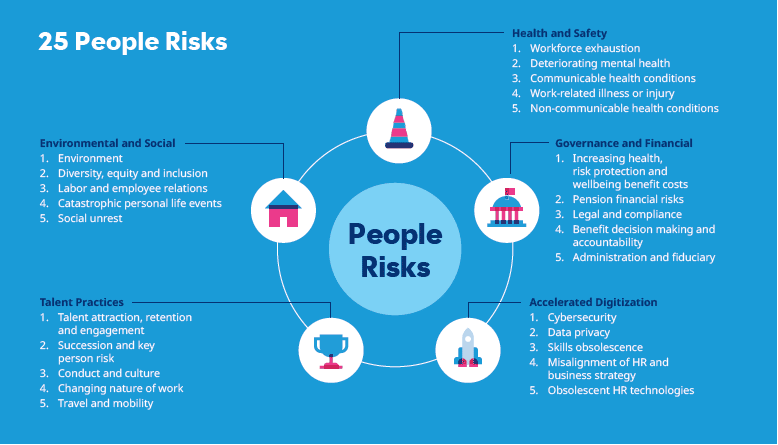
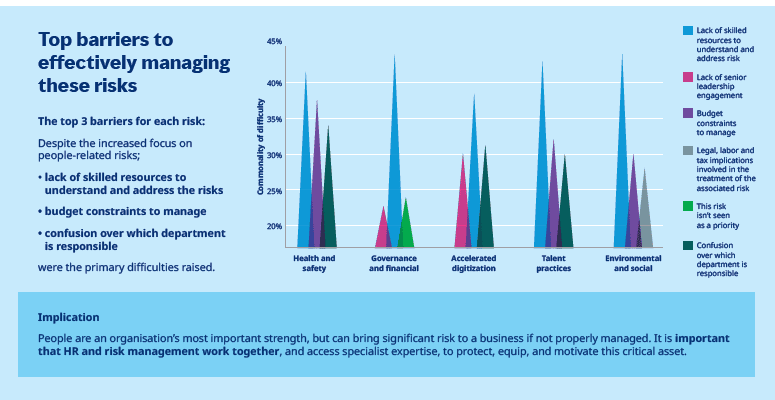
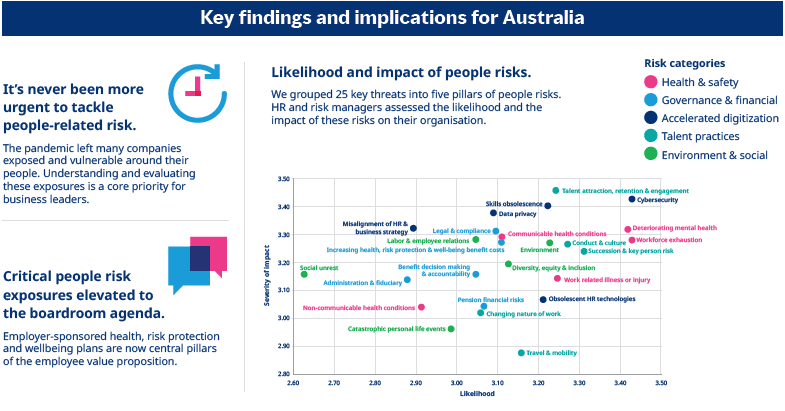
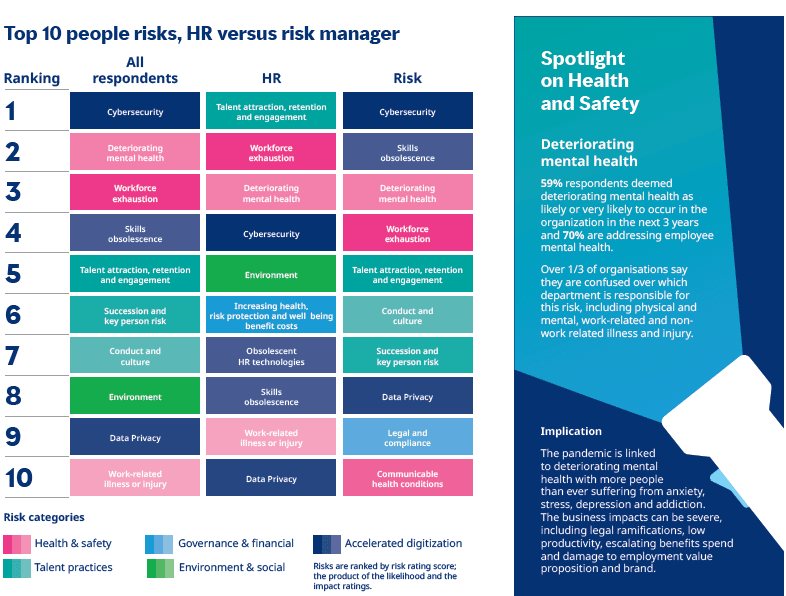
Health and Safety: Employers that proactively mitigate health issues such as physical and emotional wellbeing through targeted interventions and a culture of safety – drive a more stable business, more energised and loyal employees and better management of medical, disability and workers’ compensation claims.
Mental illness is the leading cause of long-term sickness amongst Australian workers, with work-related mental illness costing $543 million in workers’ compensation claims per annum1. It is widely reported that one in five people in Australia are living with a mental health condition2. However, the majority of mental illness seen in the workplace is treatable, and preventable, dependent on the health and wellbeing support available.
Governance and financial: Workers’ Compensation is now one of the biggest insurance spends on a company P&L, often accounting for 50% of total insurance spend3. Unlike many other lines of insurance, however businesses can influence premium outcomes through proactive prevention strategies and exceptional claims management practices.
Accelerated digitisation:
- Risks involving cybersecurity, loss of personal information and system obsolescence are heightened due to how HR data is maintained and how benefits and other HR programs are delivered. Employers are urged to seize opportunities to transform HR programs and employee benefits, such as the increase in digital health and wellbeing programs during the pandemic.
- Marsh saw a significant increase in the number of ransomware attacks across 2020, and we continue to see an elevated level of attacks this year as threat actors seek to exploit vulnerabilities created by the large-scale shift to remote working.
Talent Practices: The COVID-19 pandemic brought about 10 years’ worth of revolution in just a matter of months. The lines between personal and professional obligations blurred, virtual collaboration became a lifeline for organisations and essentially, the world of work fundamentally changed in ways that are likely to outlast the pandemic.
“Australia’s talent shortage is an undeniable business risk for many organisations. It highlights the need to reimagine the employer-employee relationship, build robust talent pipelines, and deliver on a compelling total value proposition and employee experience. This will contribute to customer retention, growth and business evolution.” Cynthia Cottrell Career Business Leader, Mercer Pacific
Environmental and social risks: The pandemic has highlighted the importance of traditional employee benefits like medical, life, disability and accident insurance as well as the inadequacies in areas like prevention, mental health, debt management and savings. These shortcomings strain the current workforce and ultimately hinder business performance.
Disparities and inequities for disadvantaged groups, including lack of access to education, employment opportunities, digital technology and savings plans have widened the protection gap and pose reputation risks for businesses. As such, many are increasingly reviewing their benefit plans through Environment, Social and Governance (ESG), Diversity, Equity & Inclusion (DEI) and employee relations lenses.
Managing and mitigating people risk: Keeping people safe and protected at work, with appropriate safety systems in place to manage pandemic related risks, will need to be a critical consideration for organisations as they navigate an ongoing need for infection control protocols.
Employers should think about benefits that support employees beyond the pandemic. As employees continue to demand flexibility about how, when and where they work, businesses should pay close attention, in particular to workforce exhaustion and mental health.
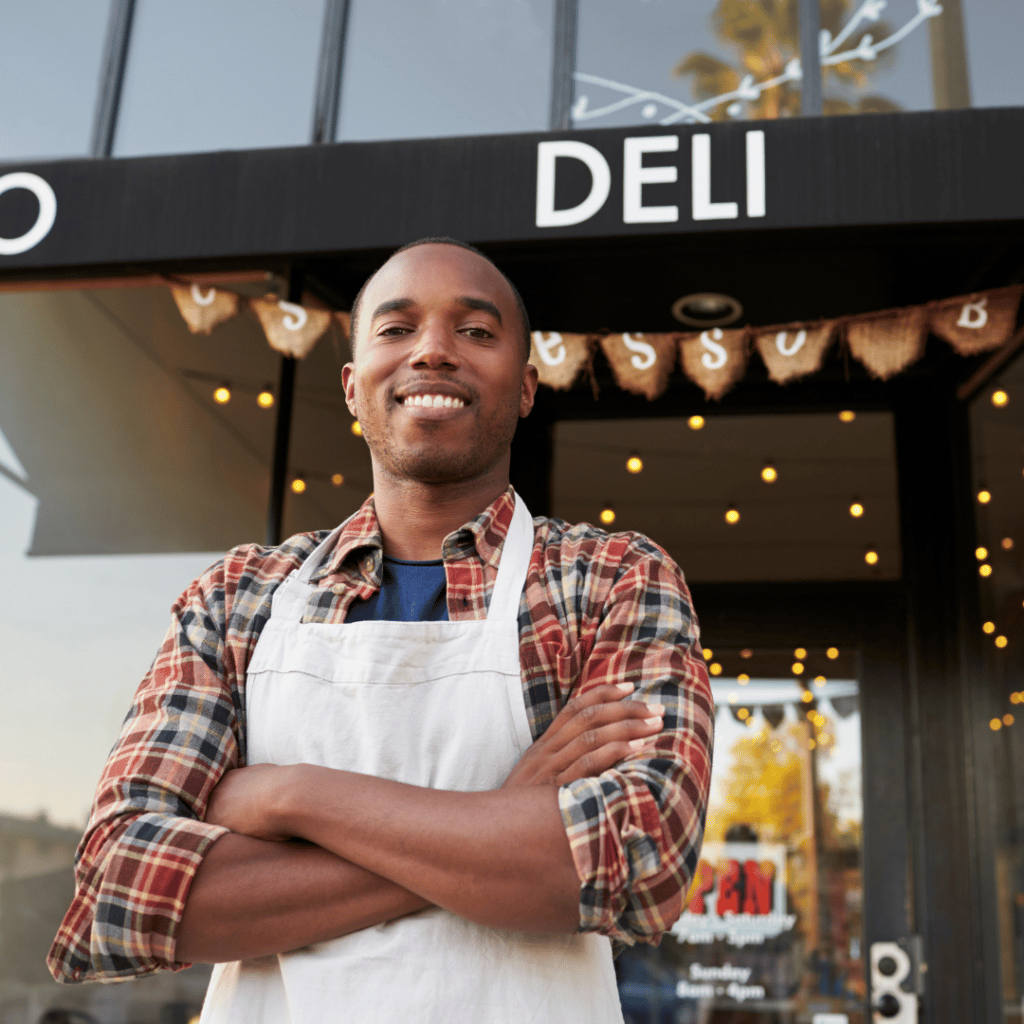
The Five Pillars of People Risk report shares solutions and practical tips towards mitigating people risk and becoming more resilient.
Interested in insurance solutions risk advisory for your business? Contact the ARA Insurance team at Marsh on 1300 133 988 or at arainsurance@marsh.com to speak to them about developing an insurance and risk management program that aligns with your business risk requirements and appetite.
1 Safe Work Australia (2021) https://www.safeworkaustralia.gov.au/topic/mental-health
2 Australian institute of Health and Welfare (2020) Australia’s health 2020 data insights, Australia’s health series no.17. Cat. no. AUS231. Canberra: AIHW.
3 MMB, The Five Pillars of People Risk, Managing risks for workforce and business resilience, Australia, 2021. https://www.mercer.com/our-thinking/health/mmb-managing-risks-for-workforce-and-business-resilience.html
Sustainability
Luxury’s next great chapter: Lifecycles
brought to you by


Renata Yannoulis / Senior Strategist @ Fabric and TBWA\Sydney
Renata is a Senior Brand Planner for the TBWA Group’s Sydney office, and has been pivotal in establishing the strategic credentials of Fabric\TBWA over the last three years. Tapping into her natural interest and love for fashion has helped Renata drive differentiation and commercial success for Australian brands including General Pants Co., Jurlique, M.J. Bale, Bras N Things, Sheridan and Vicinity Group.
As the retail category emerges from another difficult year, hopeful signs of what the World Economic Forum calls a ‘Great Reset’ of capitalism are coming to light around the world. In short, a category once marked by consumption and convenience is being forced to refocus on essentials and sustainables.
This Great Reset has further maligned the luxury sector, compounding long-associated perceptions of excess, greed, elitism and guilty pleasure. As Millennial and Gen Z consumers drive 85% of global luxury sales growth1, their expectation for luxury brands to align with their values is becoming increasingly important.
These younger, affluent generations are better educated than any that came before them, with purchase decisions increasingly guided by social and environmental responsibility. Australia specifically is also a mature market when it comes to sustainability awareness and behaviour, 90% of Aussies claim to be more likely to purchase ethical and sustainable products since the pandemic hit[2].
- Luxe Guilt: Overall, consumers are more likely to feel guilty about purchasing an unsustainable luxury product than a fast fashion item, due to higher expectations of their credentials[3]
- Politically Polarised: 64% of consumers will buy, or boycott, a brand solely because of its position on a social or political issue[4]
- Trend-proof Purchasing: Consumers now cite newness as one of the least important attributes when purchasing clothing[5]
- Secondhand Surge: 34% of True-Luxury consumers sell secondhand products, while a record 26% buy pre-owned goods6
#1 WAY IN: UPSCALE ECO MATERIALS.
Low impact materials are giving luxury a fresh look

Fashion’s waste problem has been edging into mainstream consciousness over the last decade, and yet, 92 million tonnes of raw fashion material ends up in landfill every year[7]. As collective climate concerns grow, society is doing away with traditional signals of affluence (e.g. fur, leather), instead acknowledging a new kind of premium via technological feats such as carbon-positive cotton, bio-based plastics and other eco-friendly materials.
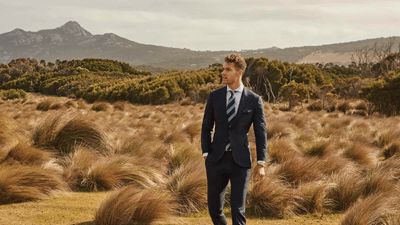
#2 WAY IN: AUTHENTICITY TRACKERS.
A product’s past life is becoming its biggest selling point


#3 WAY IN: FUNCTIONAL LUXE.
In the future of luxury, function comes first

Luxury’s legacy up until recently has been remembered for ostentation and aesthetics, rather than utility or wearability. But as societal values shift, so too are our notions of premium. In 2020 we watched the personal luxury goods market fall 23%[16], and with it, the old luxury playbook was thrown out the window. We’re moving towards the intersection of function meets fancy.
As far back as 2017, street-style blogs were tracking the rise of ‘Gorpcore’ — a name given to the trend for high-end outdoor-wear, coined by The Cut[17]. Gorpcore’s more recent proliferation is largely driven by a broader ‘return to basics’ trend exacerbated by global lockdowns – characterised by cutting consumption habits, embracing essentials and reprioritising experiences. Thus, Gucci was wise to collaborate with The North Face for 2021 and 2022 capsule collections. The highly hyped collections include tents, sleeping bags and outdoor apparel for a fashion-forward, affluent explorer.
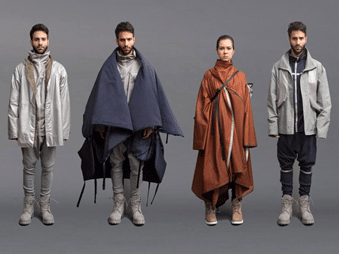
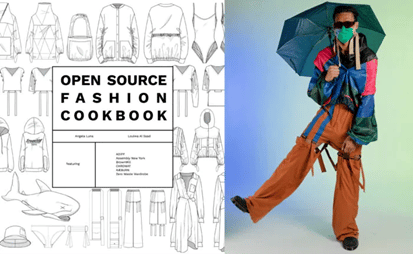


Report Synopsis – This report was born from months of in-depth qualitative and quantitative research, strategic ideation, and collaboration among 31 of our Culture Spotters from 16 global TBWA offices. Our Spotters bring expertise from their work on some of the world’s biggest retailers—from IKEA to Uniqlo to Albert Heijn. Backslash is a cultural intelligence unit powered by the global TBWA collective. Renata Yannoulis is a Senior Strategist for Fabric and TBWA\Sydney.
[1] Bain: “Eight themes that are rewriting the future of luxury goods”
[2] The Fifth Estate: “90% of Australian consumers want sustainable products”
[3] International Journal of Research in Marketing: “An investigation of unsustainable luxury: How guilt drives negative word-of-mouth
[4] Edelman: “Two-Thirds Of Consumers Worldwide Now Buy On Beliefs”
[5] McKinsey: “Survey: Consumer sentiment on sustainability in fashion”
[6] BCG: “2019 True-Luxury Global Consumer Insight”
[7] BBC: “Why clothes are so hard to recycle”
[8] Waste Advantage Magazine: “The Evolve Chair is Made of Recycled Plastic from Discarded Laptops”
[9] Stylus: “Materials Evolution: S/S 2023”
[10] Woolmark: “Suiting: M.J. Bale Innovation, carbon neutral wool”
[11] Stylus: “Materials Evolution: S/S 2023”
[12] Luxe Digital, BCG, Altagamma: “2019 True – Luxury Global Consumer Insight”
[13] Forbes: “Why The RealReal And Stella McCartney Are Calling For Luxury Brands To Embrace Reselling”
[14] WWD: “Isabel Marant launches vintage site endowment fund”
[15] AFR: “SwapPay will be Australia’s First Cryptocurrency for fashion”
[16] Bain: “Covid-19 crisis pushes luxury to sharpest fall ever but catalyses industry’s ability to transform”
[17] The Cut: “New Fashion Trends Normcore to Gorpcore”
[18] Klarna: 2020 Holiday Retail Report
[19] WBUR: “Design Label ADIFF Reimagines Fashion With Upcycling In New ‘Fashion Cookbook’”
[20] Hypebeast: ‘Salomon Debuts Recyclable Index.01 Running Sneaker’
Ethical Investment
brought to you by


Leilani Weier / Head of Responsible Investment @ Rest
Leilani Weier is the Head of Responsible Investment, having joined Rest in August 2019. As an experienced Responsible Investment, ESG and Sustainability leader, Leilani has implemented successful ESG related strategies across sectors and geographies, having builtand led high performing teams. Leilani is a strategic thinker and an organisational influencer and change maker.
Rest has a proud history of looking after hard working Australians in the retail sector with fair, simple and progressive super options. Competitive returns and low fees have always been important, but we also know our members want their money invested for the good of society.
In March 2021, we launched Sustainable Growth, our ethical and sustainable investment option that gives our members more choice in how their super is invested. It was the culmination of an extensive research and engagement program to co-design the offer with our members, giving them a voice in choosing the name of the investment option, as well as an active role in shaping the types of investments for inclusion and exclusion.
Given many of Rest’s members come from the retail sector, we wanted to share our research findings with you as an insight into what ethical and sustainable investing meant to the Rest members who participated in the research to support the design of our Sustainable Growth offer.
An ethical and sustainable investment option designed in consultation with our members
At Rest, our members come from all corners of the country and all walks of life. They reside in our capital cities, regional centres and country towns. While most are in the early stages of their working lives, there are thousands who are approaching retirement. More than one million of our members are women, many of whom work in part-time, casual and lower-income jobs.
Given the diversity of Rest’s members, our first step in designing our Sustainable Growth offer was to establish a consensus view on the companies and industries members did not want their super invested in. This feedback was first provided during Rest’s 2019 Responsible Investment survey of 2,030 members, as well as three qualitative focus groups with 25 members.
A key finding was that 73 per cent of Rest members surveyed supported the introduction of a new ethical and sustainable option, in addition to the investment options available at the time. The survey also provided early insights into the investment exclusions that were important to Rest members:
- Companies involved in unethical supply chain practices
- Industries involved in animal cruelty
- Companies involved in gender discrimination
- Companies with a recent track record of environmental damage
- Companies with excessive executive remuneration
- Tobacco, gambling, logging and fossil fuel industries.
Respondents are very positive about Rest SRI option
77% are ‘interested’ or ‘love it’.
This interest is driven primarily by preferences such as:
- Investments are sustainable
- Aligns with my values
- Positive impact on important issues
- Investment transparency
Recognition for Rest’s commitment to responsible investing
Rest was awarded Best Customer Experience Initiative in the Ashton Media CX Awards 2021, for the way we co-developed Sustainable Growth with our members. Rest was also acknowledged as a Responsible Investment Leader by the Responsible Investment Association Australasia (RIAA) in their Responsible Investment Benchmark Report Australia 20212.
The RIAA assessed our commitment to responsible investment and transparency; how we integrate ESG into our investment processes, our practices as an active asset owner; and how we invest in assets that generate competitive returns and have a positive impact to society.
Pleasingly, Rest has also been named as one of the 13 leading responsible investment super funds for 2021 in the RIAA’s recently released Super Study 20212. These achievements confirm that our approach, governance and ongoing program – the foundations of our responsible investment and sustainability strategy – are among the best in the superannuation industry.
If you would like to learn more about Rest’s Sustainable Growth investment option, please click here.
Helping members save the planet and their pocket
My super priorities are low fees; high returns; responsible, sustainable and ethical investing; and good customer service. I believe that an ethical investment option would perform just as well or better than Rest Core Strategy over the long term (10 years).
Rest Member
This quote from a Rest member encapsulates a consistent message we received throughout our research and engagement program – people wanted to invest for the good of the planet without paying high fees or lower returns. We already understood how important low fees were for our members, particularly in the retail sector where young or part-time workers have modest super balances. That’s why we ensured Sustainable Growth not only includes companies and industries that work for the good of the planet, but does so as one of the lowest-fee ethical and sustainable investment options in the market1.
Rest’s commitment to sustainability, responsible investment and climate change
The launch of Sustainable Growth forms part of Rest’s broader commitment to a sustainable future. We first adopted a sustainability policy in 2013 and have made significant progress in the years since. During the 2020/21 financial year, Rest committed to a net zero carbon footprint for the fund by 2050 and released its roadmap to net zero emissions by 2050, introduced a Supplier Code of Conduct and published a Modern Slavery Statement.
If you are interested in learning more about Rest’s progress over the last financial year, please click here to read our inaugural Sustainability, Responsible Investment and Climate Change Supplement.
[1]Source: SuperRatings Sustainable Survey fee comparison as at 30 June 2021. Fees are for a $50,000 member account balance, including fixed dollar and percentage-based administration fees, investment fees and indirect cost ratios (ICRs). All fees used in this comparison are based on the sustainable balanced options from the funds’ publicly available Product Disclosure Statements. Contribution fees, entry fees, exit fees, additional adviser fees or any other fees are excluded from this comparison. SuperRatings Pty Limited does not issue, sell, guarantee or underwrite this product. Go to superratings.com.au for details of its ratings criteria. Fees are subject to change. Ratings, awards or investment returns are only one factor that you should consider when deciding how to invest your super.
2Go to responsibleinvestment.org for more information about the Responsible Investment Benchmark Report Australia 2021 and Super Study 2021
This information is current as at 30 June 2021. Issued by Retail Employees Superannuation Pty Limited ABN 39 001 987 739 (Rest), trustee of Retail Employees Superannuation Trust ABN 62 653 671 394 (Fund). This information has been prepared without taking account of your objectives, financial situation or needs. Before acting on the information or deciding whether to acquire or hold a product, consider its appropriateness and the relevant PDS and TMD which is available at rest.com.au/pds
The cost of providing financial services is included in the fees as disclosed in the relevant PDS. Rest and the Fund do not charge additional fees or obtain commissions for the advice provided. Rest employees are paid a salary and do not receive commissions. They may receive a performance related bonus that takes into account the financial services provided. Super Investment Management Pty Limited, a wholly owned company of Rest, manages some of the Fund’s investments. Rest has no other relationships or associations with any related body corporate or product issuer that might reasonably be expected to influence Rest in providing financial services. For more information, contact us at rest.com.au/contact-us






















